
The family Stylidiaceae is a taxon of dicotyledonous flowering plants. It consists of five genera with over 240 species, most of which are endemic to Australia and New Zealand. Members of Stylidiaceae are typically grass-like herbs or small shrubs and can be perennials or annuals. Most species are free standing or self-supporting, though a few can be climbing or scrambling.
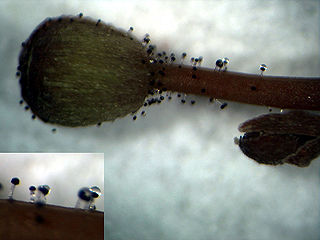
Stylidium fimbriatum is a dicotyledonous plant that belongs to the genus Stylidium. It is an erect annual plant that grows from 15 to 30 cm tall. Oblanceolate leaves, about 16 per plant, form a basal rosette around the compressed stems. The leaves are generally 5–20 mm long and 2–7 mm wide. This species generally has one or two scapes and cymose inflorescences that are 15–30 cm long. Flowers are pink with yellow highlights. S. fimbriatum's distribution is confined to the area around Bachsten Creek in the Kimberley region in Western Australia. Its typical habitat is herbfields that are seasonally wet.
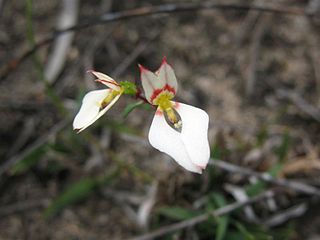
Levenhookia, also known as the styleworts, is a genus of ten recognized species in the family Stylidiaceae and is endemic to Australia. The genus is restricted to Western Australia almost exclusively with a few exceptions: L. pusilla's range extends into South Australia, L. dubia's range extends through South Australia into Victoria and New South Wales, L. sonderi is native only to Victoria, and L. chippendalei is also found in the Northern Territory.
Levenhookia chippendalei is a dicotyledonous plant that belongs to the genus Levenhookia. It is named after its discoverer, George Chippendale, founder of the Northern Territory Herbarium. It grows from 8–18 centimetres (3.1–7.1 in) tall with oblanceolate leaves near the base of the plant. The few leaves this species produces are generally 2 millimetres (0.079 in) long. The inflorescences are racemose. Flowers are pink with 4–5 millimetres (0.16–0.20 in) long petals. The sensitive labellum is hood-like and dark red with yellow appendages. L. chippendalei is most closely related to L. preissii but differs in flower morphology. It shares a similar floral arrangement with Levenhookia stipitata.

Levenhookia dubia, the hairy stylewort, is a dicotyledonous plant that belongs to the genus Levenhookia. It is an ephemeral annual that grows from 2–6 centimetres (0.79–2.36 in) tall with obovate leaves that are generally 2–5 millimetres (0.079–0.197 in) long. Flowers are white and bloom from September to October in its native range. L. dubia is most closely related to L. sonderi, which has been described as a variety of L. dubia in the past. It is endemic to Australia and has native ranges in Western Australia, South Australia, New South Wales, and Victoria. Its habitat has been reported as being sandy soils in granite outcrops.
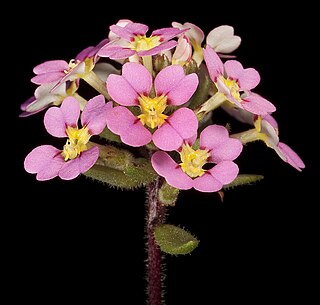
Levenhookia leptantha, the trumpet stylewort, is a dicotyledonous plant that belongs to the genus Levenhookia. It is an ephemeral annual that grows from 2–6 centimetres (0.79–2.36 in) tall with ovate to lanceolate leaves that are generally 2–5 millimetres (0.079–0.197 in) long. Flowers are pink and bloom from September to October in its native range. It is endemic to Western Australia. Its habitat has been reported as being sand or sandy clay soils in granite outcrops and winter-wet depressions.
Levenhookia octomaculata, the dotted stylewort or eight-spotted stylewort, is a dicotyledonous plant that belongs to the genus Levenhookia. The specific epithet octomaculata refers to the eight red dots this plant produces on each flower. It is an ephemeral annual that grows from 4–10 centimetres (1.6–3.9 in) tall with a simple or branched stem. There are very few leaves that are obovate to spathulate and mostly around the base of the stem. Scapes are umbellate and dark-coloured. Flowers are bright pink with white throats and two red dots borne on each petal. L. octomaculata blooms from September to October in its native range. It is endemic to Western Australia. Its habitat has been reported as being sandy soils in open Acacia acuminata or Eucalyptus wandoo forests in compact colonies. Because this species is known from several populations that are not believed to be under immediate threat but are poorly known, this species has been declared a priority three species, which means it is under consideration for rare status but more information must be gathered first.

Levenhookia pauciflora, the deceptive stylewort, is a dicotyledonous plant that belongs to the genus Levenhookia. It is an ephemeral annual that grows from 5–10 centimetres (2.0–3.9 in) tall with ovate to suborbicular leaves. Flowers are white and bloom from September to November in its native range. L. pauciflora is endemic to Western Australia where it grows in sandy soils in sandstone or granitic areas. The flowers of L. pauciflora resemble those of Stylidium ecorne and it has been said that S. ecorne mimics L. pauciflora to take advantage of its pollinators.
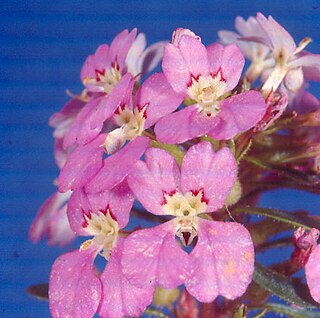
Levenhookia pulcherrima, the beautiful stylewort, is a dicotyledonous plant that belongs to the genus Levenhookia. It is an ephemeral annual that grows on average from 7–8 centimetres (2.8–3.1 in) tall. Lower leaves are spathulate while upper leaves are oblanceolate and up to 1.8 centimetres (0.71 in) long. Stems and older leaves are red. Flowers are pink to rose-coloured with the shorter anterior petals about 3 millimetres (0.12 in) long. The sensitive labellum is obovate and white with a circular grey-purple mark on either side of the terminal portion. Both leaves and stems of L. pulcherrima possess more glandular trichomes than in other Levenhookia species. When describing this new species, Sherwin Carlquist noted that it is most closely related to L. preissii and L. pauciflora, which might place it with those species in section Levenhookia, but Carlquist neglected to specifically say so. He also noted that several features of this species, including its corolla lobe, labellum, throat appendage, and stigma morphology, are distinctly different from those species with which it appears to be associated. L. pulcherrima is endemic to southwestern Western Australia.
Levenhookia pusilla, the midget stylewort or tiny stylewort, is a dicotyledonous plant that belongs to the genus Levenhookia. It is an ephemeral annual that grows about 5 to 6 cm tall with suborbicular to ovate-spathulate leaves. Flowers are pink to white and bloom from September to December in its native range. L. pusilla is endemic to southwestern Western Australia and South Australia where it grows in granitic or lateritic soils.
Levenhookia sonderi, the slender stylewort, is a dicotyledonous plant that belongs to the genus Levenhookia. It is an ephemeral annual that grows only in Victoria, Australia. L. sonderi is most closely related to L. dubia and it has even been described as a variety of L. dubia in the past. Johannes Mildbraed was the first person to reduce L. sonderi to a variety of L. dubia in his 1908 taxonomic monograph on the Stylidiaceae in which he noted he could not find any significant difference between L. sonderi and L. dubia to maintain the separate taxonomic treatment of the two species. Later studies have considered the species to be distinct.
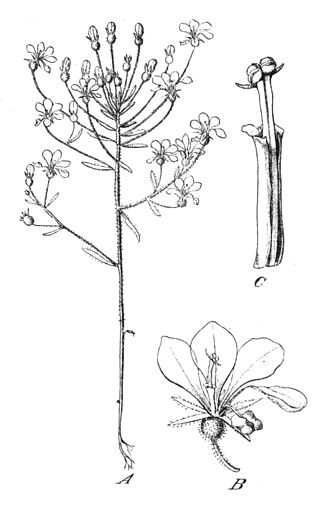
Levenhookia stipitata, the common stylewort, is a dicotyledonous plant that belongs to the genus Levenhookia. It is an ephemeral annual that grows about 7–10 centimetres (2.8–3.9 in) tall with oblanceolate to linear leaves. Flowers are pink and bloom from August to January in its native range. L. stipitata is endemic to southwestern Western Australia where it grows in granitic or lateritic soils. This species was first described by George Bentham in 1837 as Stylidium stipitatum and was later reclassified into the genus Coleostylis, which was placed into synonymy with the genus Levenhookia.

Levenhookia sect. Coleostylis is a section of four recognized species in the family Stylidiaceae. It was established and described by Johannes Mildbraed in 1908 to separate the subgeneric taxonomy in the genus Levenhookia. Mildbraed originally placed L. preissii and L. stipitata in this section. L. chippendalei was described in 1966 and placed in this section by Rica Erickson and Jim Willis. Section Coleostylis could also contain L. octomaculata, which Erickson described in 1956, noting its affinities with L. stipitata but without placing it in a section. Otherwise it would be unplaced as to a section.
Levenhookia sect. Estipitatae is a section of two to three recognized species in the family Stylidiaceae. It was established and described by Johannes Mildbraed in 1908 to separate the subgeneric taxonomy in the genus Levenhookia. Mildbraed originally placed L. dubia and L. leptantha in this section. L. sonderi was described by Mildbraed as a variety of L. dubia, though other resources treat it as a distinct species.

Levenhookia sect. Levenhookia is a section of two to three recognized species in the family Stylidiaceae. Section Levenhookia was originally described by Mildbraed as section Eulevenhookia, which was later changed to the current section title Levenhookia as an autonym since it is the type section. Mildbraed originally placed L. pauciflora and L. pusilla in this section. It could also contain L. pulcherrima, which Carlquist described in 1969 and noted its close association to the other two species in section Levenhookia but neglected to place it within a section.
Stylidium aceratum is a dicotyledonous plant that belongs to the genus Stylidium. It occurs within the south west region of Western Australia
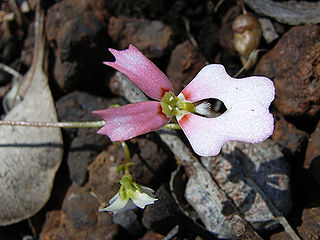
Stylidium subg. Centridium is a subgenus of Stylidium that is characterized by a globose hypanthium, a stipitate brush-like stigma, and gynostemium mobility not produced by a sensitive hinged torosus but by the movement of a cunabulum. All species with the possible and doubtful exception of S. weeliwolli are annuals. This subgenus appears to be most closely related to the genus Levenhookia, which suggests an ancestral relationship. Centridium was first published by John Lindley in the 1839 publication, A Sketch of the Vegetation of the Swan River Colony. Lindley created this subgenus to distinguish species which did not fit into either of the two other subgenera that had existed at the time. He initially placed Stylidium calcaratum, the newly described Stylidium androsaceum, and Stylidium stipitatum into subgenus Centridium. His description of S. androsaceum turned out to be synonymous with S. calcaratum and S. stipitatum is a synonym of Levenhookia stipitata.
Stylidium leeuwinense is a species that belongs to the genus Stylidium. The specific epithet leeuwinense refers to the Cape Leeuwin region in Western Australia where the type location for this species is. It is an herbaceous perennial that grows from 15 to 60 cm tall and has divided stems covered with tile-like leaves that are arranged in a spiral formation around the stem. The lanceolate leaves are basifixed and held closely against the stems. The leaves are around 2.5-3.5 mm long and 0.5-0.8 mm wide. Terminal inflorescences are racemose or spike-like and produce flowers that are reddish purple with laterally-paired lobes and bloom from February to May in their native range. S. leeuwinense is only known from south-western Western Australia along the coast from Augusta to Denmark. Its habitat is recorded as being black, peat-sand soils in swampy areas or heathland. S. leeuwinense, along with S. preissii, is distinct within its subgenus because it possesses leaves without an apical mucro. It differs from S. preissii by its spike-like racemes.

Stylidium marradongense is a species that belongs to the genus Stylidium. The specific epithet marradongense refers to the Marradong region in Western Australia where the species is located. It is an herbaceous perennial that grows from 15 to 50 cm tall and has divided stems covered with tile-like leaves that are arranged in a spiral formation around the stem. The lanceolate leaves are basifixed and held closely against the stems. The leaves are around 1.5-2.0 mm long and 0.5-0.8 mm wide. Terminal inflorescences are racemose or spike-like and produce flowers that are shades of pink or white with pink at the base of the lobes and bloom from September to November in their native range. S. marradongense is only known from south-western Western Australia from Mount Saddleback to Marradong. Its habitat is recorded as being sandy laterite soils in open jarrah forest with other species such as Banksia grandis, Banksia sessilis, and Persoonia longifolia. S. marradongense is closely associated with S. preissii because they both lack throat appendages. It differs from S. preissii by its spike-like racemes, apical mucro, and conical, capitate stigmas.
Stylidium preissii, the lizard triggerplant, is a species that belongs to the genus Stylidium. It is an herbaceous perennial that grows from 5–18 cm tall and has divided stems covered with tile-like leaves that are arranged in a spiral formation around the stem. The broadly trullate leaves are basifixed and held closely against the stems. The leaves are around 1.9 mm long and 1.0 mm wide. Inflorescences are umbellate racemes and produce flowers that are white, pale pink, or dark pink and bloom from November to December in their native range. S. preissii is only known from south-western Western Australia from Bremer Bay to Israelite Bay with a few populations near Jandakot. Its habitat is recorded as being white sandy soils in open heathland. S. preissii is distinct within its subgenus because it possesses a strap-like gynostemium column with a dilated cunabulum.










